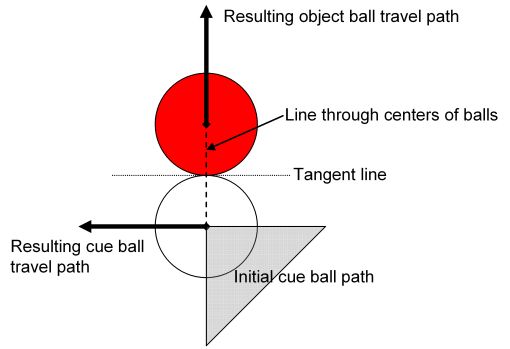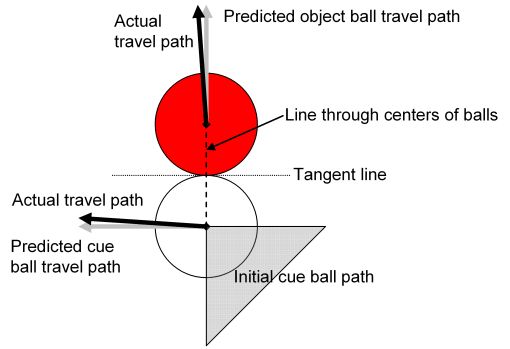First of all, pool balls only go where they’re told. If they don’t go where you want, work on communicating better with them. I’m not going to spell out all the little details, but I’ll give you enough to get started with.
Frozen Balls
In the simplest case, when a cue ball hits an object ball, the resulting path of the object ball will be along the line that connects the center of the two balls at contact. The resulting path of the cue ball will be perpendicular (90 degrees) to that line. This is called the Ninety Degree Rule, which is very beneficial in any pool game.
So how does this apply to trick shots? First of all, you’re going to need to know how to control the cue ball coming off of an object ball. Secondly, for setup shots, when you freeze two balls together, the line between the two centers of the balls are fixed, so the ball that doesn’t get hit directly (the “object ball” in the previous example) will travel in that direction and the ball that gets hit (the “cue ball”) will travel perpendicular to that line if it is hit within the area shown by the shaded triangle. The exact angle of the hit will alter the speed at which both balls move along their travel paths. This is why it is important when you see setup shots where balls are frozen, that they are indeed frozen and there isn’t a gap. This is also why you’ll see players tap the balls in place so they don’t move around.
Friction Effects
Once you get that down, friction starts to complicate matters. When two balls come in contact with each other, there is friction between them which will cause the balls to spin and throw, affecting their travel path.
Throw is the deviation of an objects ball travel path due to friction. If we take the example above where the two balls are frozen, the travel path of the object ball that doesn’t get hit will actually veer off a little bit to in the direction of the first ball because the ball that hits it will pull it that way. Similarly, the ball that gets hit will push through the contact point just a little bit, and so will end up veering right of the diagrammed direction. The amount of deviation from the predicted travel path will be determined by the amount of friction between the balls (dirtier balls provide more friction), the initial hit angle, and the hit speed.
Spin is also induced when an object ball is hit. If it is struck on the left side, then left english is induced. Likewise, an object ball struck on the right side will pick up right english. This is most pronounced once the object ball hits the rail, such as in my Two and Three Rail Reverses.

